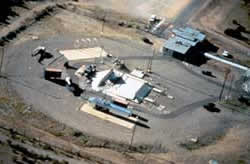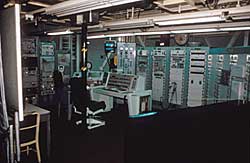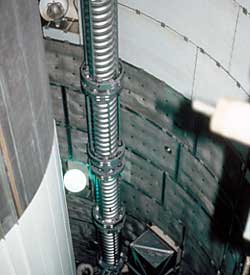
Air Force Facility Missile Site 8 (571-7) Military Reservation in Green Valley, Arizona, is the sole remaining Titan II Intercontinental Ballistic Missile (ICBM) complex of the 54 that were "on alert" during the Cold War between 1963 and 1987. The Titan II missiles were contructed to survive a first strike nuclear attack from the Soviet Union and to retaliate. It is the single remaining example of the liquid-fueled ICBM missile launch facilities utilized by the Strategic Air Command. Titan II carried the largest single warhead used in the ICBM program and was capable of destroying targets that Atlas, Titan I and Minuteman I and II could not. Built in response to the "missile gap" panic of the late 1950s and early 1960s, Titan II Missile Site 571-7 provides a unique window into the design, construction and operation of a weapon system built to survive a first-strike nuclear attack and be able to launch its missile if so ordered. The site has retained, or assembled, all of the above and below ground command and control facilities as well as the missile silo itself. Unlike the first generation Atlas or Titan I ICBMs, or the Thor and Jupiter Intermediate Range Ballistic Missiles (IRBM), Titan II utilized storable liquid propellants. Fully fueled at all times, the Titan II was ready for launch at a moment's notice. From the turn of the launch keys to lift-off took slightly less than one minute. Approximately 35 minutes and 6000 miles later, the Mark VI re-entry vehicle would have detonated on target as either an air or ground burst.

The decision to build an ICBM weapon system originated in the late 1940s but was shelved due to budgetary constraints. After the Korean War, and following the detonation of the first thermonuclear bomb by the Soviet Union in 1953, the U.S. government became convinced of the need for an ICBM weapon system despite the cost. Time was of the essence, and the 1954 summary report of Dr. John von Neumann to the Teapot Committee stressed that the need for a strategic offensive missile system was urgent. Two development tracks were recommended in the Teapot Committee report--the first was the ICBM program. Initially, it took time to load the liquid oxygen onto the missile, open the silo doors and bring the missile to the surface. The Titan I replaced the earlier Atlas missiles as the program developed, and later, with internal guidance systems came the Thor and Jupiter IRBM systems. The Titan II, designed by the Martin Company in 1958, had superior liquid propellants than the Titan I. Instead of taking 15 to 20 minutes to raise, fuel and launch Atlas or Titan I missiles, the Titan II could be launched from the underground silo in less then one minute. The entire Titan II system was on alert by December 31, 1963. In October 1981, President Reagan announced the start of the Strategic Forces Improvement Program, which called for the decision to modernize the land-based ICBM forces by retiring the Titan II system and replacing it with a more advanced system. The Salt I Treaty signed by President Nixon and Premier Brezhnev limited the United States to 1054 ICBMs. With the exception of Titan II Missile Site 571-7, all of the Titan II missile sites were destroyed over a five year period beginning in 1982.

The engineering significance of Site 571-7 re sts primarily in underground features, which were designed to insure that launch control could be maintained and operated under extraordinary circumstances. The Launch Control Center is a three-story, cylindrical concrete and steel structure within which a three-story building is suspended on massive springs. The Blast Lock structure protects the Launch Control Center from damage due to either a nearby nuclear explosion or from a missile propellants explosion. Each blast door weighs three tons and the doors were interlocked in pairs so that at least one door of each pair was closed and locked at all times.
Two nine-and-a half-foot diameter underground cableways connect the missile silo and Launch Control center to the blast lock area. The missile silo was covered by 740-ton silo closure door to protect the missile from nearby blast, radiation or inclement weather. Since the Titan II was designed to be launched from within its silo without first being lifted to the surface, unlike all previous liquid-fueled ICBM and IRBM missiles, the silo design required several unique engineering solutions. Among these problems were the dissipation of the 5000-degree F engine exhaust gasses and the reduction of the tremendous acoustical energy generated by rocket engine operation within an enclosed space. The overall Titan II Missile Site 571-7 was comprised of an approximately 10-acre circular military reservation enclosed by a four-strand barbed wire fence. Within this reservation is the actual missile site--a 3.3 acre parcel surrounded by a 6.5 foot security fence. This site is now the home of the Titan Missile Museum, which opened on May 21, 1986. Nowhere else in the United States is there such a facility open for public inspection and education. Access to this site represents a rare opportunity to educate people about the much-feared prospects of the conduct of nuclear war and the government's efforts to deter it.
Visit the National Park Service Travel American Aviation to learn more about Aviation related Historic Sites.
Last updated: November 26, 2017
